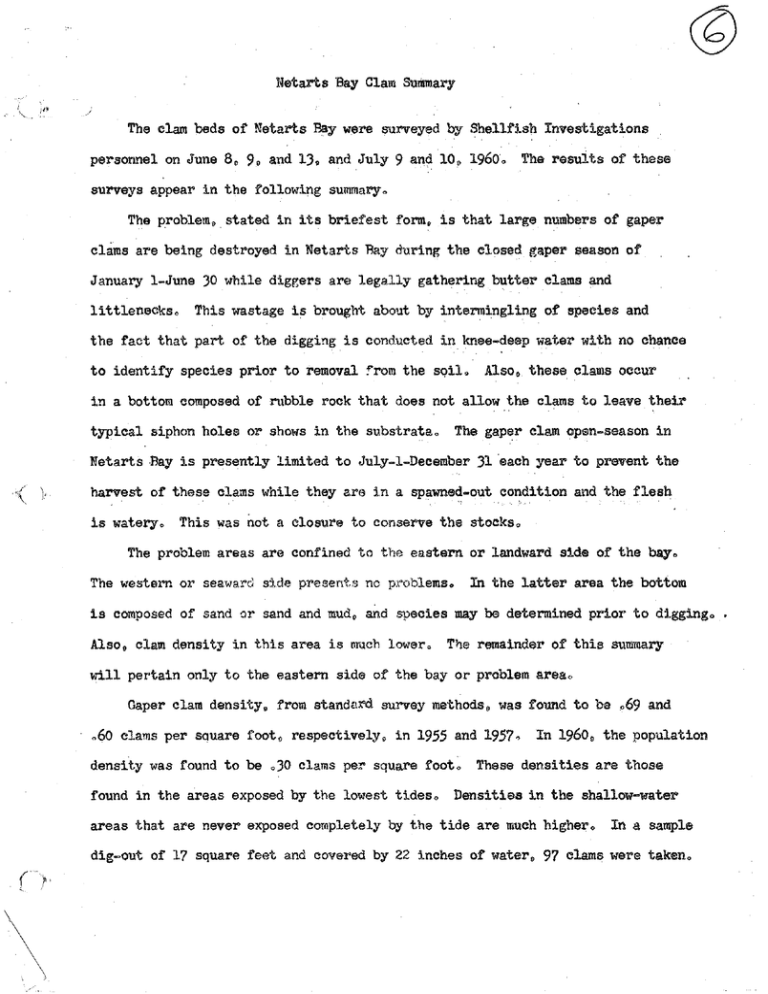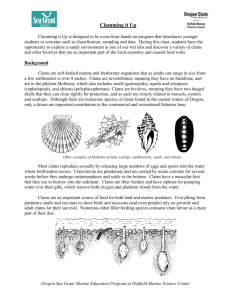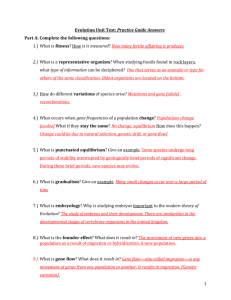Netarts Bay Clam Summary
advertisement

Netarts Bay Clam Summary
The clam beds of Netarts Bay were surveyed by Shellfish Investigations
personnel on June 8, 9, and 13, and July 9 and 10, 1960. The results of these
surveys appear in the following
sun~ary.
The problem,. stated in its briefest form, is that large numbers of gaper
cl8.ms are being destroyed in Netarts Bay during the closed gaper season of
January 1-June 30 while diggers are legally gathering butter clams and
littlenecks,
This wastage is brought about by intermingling of species and
the fact that part of the digging is conducted in knee-deep water with no chance
to identify species prior to removal from the soil.
Also, these clams occur
in a bottom composed of rubble rock that does not allow the clams to leave their
typical siphon holes or shows in the substrata.
The gaper clam open-season in
Netarts Bay is presently limited to July-1-December 31 ·each year to prevent the
harvest of these clams while they ar<> i.n a spawned-out condition and the flesh
is watery.
This was not a closure to conserve the stocks,
The problem areas are confined to the eastern or landward side of the bay.
The western or seaward s:lde presents no p.\·oblems.
In the latter area the bottom
is composed of sand or sand and mud, and species may be determined prior to d:l.gging.
Also, clam density in this area is
~~ch
lowero
T~e
remainder of this summary
will pertain only to the eastern side of the bay or problem areao
Gaper clam density, from standnX'd survey methods, was found to be .69 and
o60 clams per sauare foot, respectively, in 1955 and 1957o
density was found to be .30 clams per square foot.
found in the areas exposed by the lowest tides.
In 1960, the population
These densities are those
Densities in the shallow-water
areas that are never exposed completely qy the tide are much higher.
In a sample
dig-out of 17 square feet and covered by 22 inches of water, 97 clams were taken.
\
This would be an average of 5.7 elams per square foot (2.94 gaper elams per
square foot).
and
Of' the 97 elams, 48 tvere legal (butter elams and littleneoks)
50 w.ould have been illegal gapers. This is a ratio of 1: J. legal- clams to
illegaL
In talking to diggers in the area it was le.arned that this ratio seemed
to hold fairly true where digging was conducted in the water.
In the dry areas
the number of gapers dug was less. probably because of a lower population density.
Cape Lookout state Park is located on the southern end of Netarts Bay.
This park is quite popular and in 19.58, 1'76,000 p90ple )ltH:I.zed its facilities.
Sampling in the park in 1957 and 1960, :l.ndieated that about one-fourth of these
people dig clams, at least during the summer months of peak use.
On July 9 and J.O. 1960. diggers 1r1e1•e counted at half-hour intervals.
counts on these days were 433 and 540.
The
tota~
Peak
number of diggers that actually
dug on these days ite unknown, ho1vever, it would have been well over the figures
(
)
listed"
This is brought about by the earlier arrivals leaving before the peak
figures were reached.
During these counts 106 diggers were checked and it was
found that the average bag contained 18 clams of all species.
A m:l.nimwn catch
for these two tides would be at least 17.500 clams of all species.
At the present time much wastage of gaper clams is occurr-lng in Netarts Bay
during the closed season"
This wastage occurs while people are digging butter
clams and littlenecks which are legal t.o take while the gaper is illegal until
July .1.
Incidentally-taken gapers are left for the seagulls or fish to eato
Four alternatives exist by which this wastage can be reduced,
the eastern shore to
!!! clam
They are: {1} close
digging during the period January 1-June 30 each
·year; (2) leave the eastern shore open to clam digging for all species du:r1.ng the
entire year (bag lin1it of 36 bay c:lams per day; of
gaper clams);
~•hich
no more than 18 could be
(3) elose the entire bay from January 1-June 30; and. (4) remove the
seasonal restriction on [aper clams in Netarts Bay.
The first alternative, closing the eastern shore to all clam digging during
the period Januar,y l-June 30 each year, would prevent the harvest of all clam
species. including gapers, until July 1 of' each year in the problem area and would
eliminate the wastage of' incidentally-dug gaper clams. However, such a regulation
would also fUrther complicate the situation for the diggers.
Clam species
identification is already a problem among diggers and the problem of open and
closed areas in the same bay would indeed add to the confusion.
The second alternative is to remove the seasonal restriction on gaper clams
on the eastern shore only. This would eliminate the present waste of gaper clams
dug and damaged inadvertently
bw diggers seeking other species during ths period
January 1-June JO. Unfortunately, this would also have the same disadvantage as
alternate one. That is, the regulation would be further complicated. Furthermore.
such a regulation would hamper the enforoament of the remaining closure to gaper
(
harvest on the western shore. The enforcement officer would have to prove that
gaper clams in possession of a
dig~er
had actually been taken on the western
shore. With the present regulation, possession alone is normally sufficient.
The third alternative is to close the entire bay to clam digging during the
period Januar,y 1-June 30. Such action seems unwarranted at this time since there
is no evidence available that indicated that any species .needs protection to
maintain the resource. This would be tantamount to letting the tail wag the dog.
The fourth alternative is to remove the seasonal restriction on gaper clams
in all of Netarts. If the inadvertent wastage of' discarded gaper clams during the
January 1-June 30 closed period has now reached appreciable proportion. then it is
apparent that the seasonal restriction to "saven these clams .for harvest when they
are in better condition is not serving its purpose and should be removed.
Considering only the welfare of the resource, the removal of the restriction
'
\.
.
1
on the eastern shore seems most desirable.
However. this procedure would be likely
to further confuse the diggers and inhibit the enforcement of the regulationso
4.
Therefore, it is the ·Staff 0 s recommendation that the seasonal closure be
removed and the result closely watched,
C. Dale Snow
Shellfish Investigations
September 14, 1960
(
(
I






